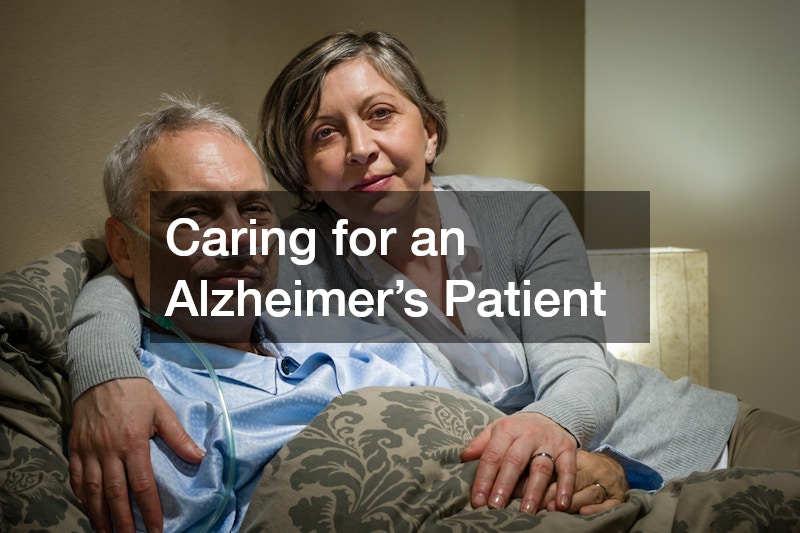
When someone you love has Alzheimer’s disease, you may feel devastated. Their level of dementia will determine the extent to which they can care for themselves and interact with family members. Many families with loved ones in the beginning stages of Alzheimer’s disease will initially try to utilize dementia rehab. According to the NIH, cognitive rehabilitation may be useful in the beginning stages to help the client adapt to their memory changes.
At one point in the later stages of Alzheimer’s, most clients need some senior care option. While many families might prefer their loved ones to remain at home, safety factors may dictate the need for a facility that provides Alzheimer’s disease nursing care. Some senior care facilities will have locked units for Alzheimer’s nursing interventions – to prevent the wandering that is characteristic of clients in the earliest stages of this disease.

When clients with Alzheimer’s develop other diseases (especially urine infections or pneumonia), they can exhibit behavioral changes, such as aggression. If their aggression persists, you may need to look among care homes for aggressive dementia patients. If clients with Alzheimer’s disease have surgery, they may need to have special supervision in a post-surgical rehabilitation program.
Several health issues are common to aging Americans, such as joint pain, lower back pain, reduced vision and hearing, and mental issues such as dementia. Alzheimer’s disease is particularly well known, and although it cannot be cured or prevented, its onset can be delayed and slowed down, and many options exist for caring for such a patient to make his or her life more comfortable, safe, and dignified. An Alzheimers care facility is a type of specialized care for such patients, and a nursing facility and its staff can go a long way to caring for these patients and making their lives easier to manage. Mental health is something to take just as seriously as physical health, and an Alzheimers care facility will be ready to receive any patient who needs care.
Alzheimers Disease and Treatment
Alzheimers disease is one of the ten most prolific causes of death in the United States, and it cannot be truly cured or prevented, merely treated. Among all dementia diagnoses, Alzeimers makes up 80% of all cases, and most people who suffer this condition are aged 65 or over, although around 200,000 Americans under 65 are patients of early-onset Alzheimers, and they will need care, too. An Alzheimers care facility will handle the symptoms of this disease, which may include memory loss and cognitive impairment, as well as physical clumsiness and decreased motor skills. This means that both mental and physical aid will be needed for such a patient. Treatment for Alzheimers patients may vary based on whether the patient is at a nursing home or in their own residence, and the family of the patient may decide what is best for the patient based on finances, distances involved, and amenities found in the residence. Different arrangements will work best for different patients.
Memory care for Alzhiemers patients can be done at the patient’s home if the right steps are taken. This option also works best if family and health care professionals can easily reach the residence based on terrain and the distances involved; a faraway, remote home may mandate relocating the patient to an Alzheimers care facility. But if care is possible at the home, the home should first be made safe. Tripping hazards such as items on the floor, rugs, and electrical cords should be cleared away, and sharp or flame-producing items such as scissors, knives, and matches should be either removed or kept under lock and key, only to be used by care providers. Also, keeping all items in a logical and clear arrangement, and keeping it that way, can minimize the impact of memory loss, and the less clutter, the better. Sentimental photographs on dressers and fireplace mantles can also help.
Family members and health care providers can visit to assist in chores such as doing dishes, vacuuming, yard work, taking care of pets, and more. On top of that, family members and other assistants can provide mental stimulation that will cheer up the patient and help slow down Alzheimers effects, anything from conversation to puzzles and games to engage the mind. It has been shown that completing jigsaw puzzles can boost cognitive performance and memory in any user, and this can have a mild beneficial effect on Alzheimers patient. If the patient wants to go outside for errands or walks, he or she should carry a name tag with their address and a family member’s phone number in case they get lost or hurt while outside.
If the patient’s residence is too far away, or if their condition grows serious enough, it may be best to move him or her to an Alzheimers care facility that is near enough to visit. Such a facility will probably provide 24 hour care from its staff, and the community offers a strong social life for all residents, as well as all amenities and medical services needed for Alzheimers and any other conditions the residents are dealing with. An Alzheimers care facility may be expensive, however, so the patient and their family should be prepared for the expenses, and a patient may be unwilling to move into one. Convicting a reluctant patient to move into one may fall to their family and/or care providers, who can sell them on the facility’s health care, community, and convenience for family visits.
